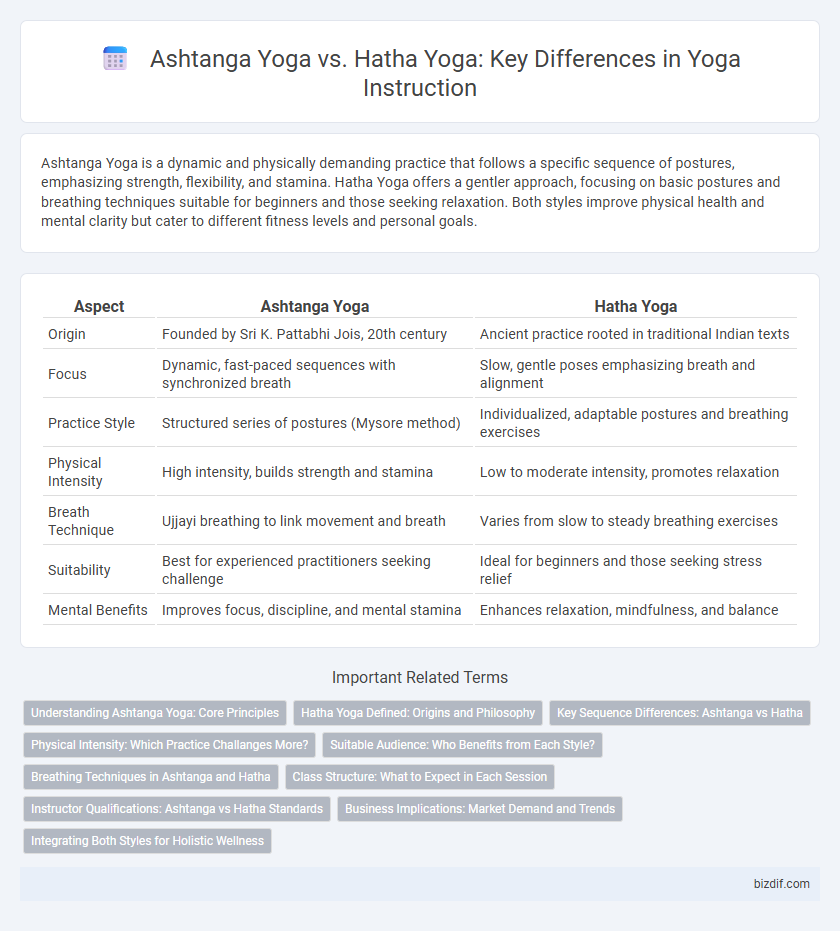Ashtanga Yoga is a dynamic and physically demanding practice that follows a specific sequence of postures, emphasizing strength, flexibility, and stamina. Hatha Yoga offers a gentler approach, focusing on basic postures and breathing techniques suitable for beginners and those seeking relaxation. Both styles improve physical health and mental clarity but cater to different fitness levels and personal goals.
Table of Comparison
| Aspect | Ashtanga Yoga | Hatha Yoga |
|---|---|---|
| Origin | Founded by Sri K. Pattabhi Jois, 20th century | Ancient practice rooted in traditional Indian texts |
| Focus | Dynamic, fast-paced sequences with synchronized breath | Slow, gentle poses emphasizing breath and alignment |
| Practice Style | Structured series of postures (Mysore method) | Individualized, adaptable postures and breathing exercises |
| Physical Intensity | High intensity, builds strength and stamina | Low to moderate intensity, promotes relaxation |
| Breath Technique | Ujjayi breathing to link movement and breath | Varies from slow to steady breathing exercises |
| Suitability | Best for experienced practitioners seeking challenge | Ideal for beginners and those seeking stress relief |
| Mental Benefits | Improves focus, discipline, and mental stamina | Enhances relaxation, mindfulness, and balance |
Understanding Ashtanga Yoga: Core Principles
Ashtanga Yoga is a dynamic and physically demanding practice that follows a set sequence of postures synchronized with breath, emphasizing vinyasa flow to build strength, flexibility, and endurance. Rooted in the Yoga Korunta texts, its core principles include daily practice (sadhana), Trishtana (three focal points: posture, breathing, and gaze), and bandhas (energy locks) to control prana and enhance internal awareness. This disciplined approach contrasts with Hatha Yoga's broader style by focusing on precise alignment and rigorous physical discipline to achieve mental clarity and spiritual growth.
Hatha Yoga Defined: Origins and Philosophy
Hatha Yoga, originating from ancient Indian texts like the Hatha Yoga Pradipika, emphasizes physical postures (asanas), breathing techniques (pranayama), and meditation to balance body and mind. Rooted in a philosophy that aims to unite the solar and lunar energies within the body, Hatha Yoga serves as a foundational practice for many modern yoga styles. This practice promotes holistic well-being by cultivating strength, flexibility, and mental clarity through its systematic approach.
Key Sequence Differences: Ashtanga vs Hatha
Ashtanga Yoga follows a fixed, dynamic sequence of postures that flow in a specific order, emphasizing continuous movement and breath synchronization, while Hatha Yoga offers a more flexible and varied approach to posture arrangement, focusing on holding poses longer for alignment and breath control. The Ashtanga sequence is structured into six series, each increasing in difficulty, designed to build strength, flexibility, and stamina progressively. Hatha Yoga sequences can vary widely, incorporating a mix of poses tailored to individual needs or goals, often balancing effort with relaxation.
Physical Intensity: Which Practice Challanges More?
Ashtanga Yoga demands higher physical intensity with its dynamic, fast-paced sequences that build strength, flexibility, and cardiovascular endurance. Hatha Yoga emphasizes slower, more deliberate postures focused on alignment and breath control, offering a gentler, less intense physical challenge. Practitioners seeking vigorous workouts typically find Ashtanga Yoga more challenging, while Hatha Yoga caters to those preferring moderate physical engagement.
Suitable Audience: Who Benefits from Each Style?
Ashtanga Yoga suits individuals seeking a dynamic, physically demanding practice that builds strength and endurance, ideal for those with prior yoga experience or athletic backgrounds. Hatha Yoga benefits beginners and individuals looking for a gentler, slower-paced practice that emphasizes alignment, breath control, and relaxation. Both styles offer therapeutic advantages, but Hatha's accessibility makes it favored for stress relief and flexibility improvement, while Ashtanga supports cardiovascular fitness and muscle toning.
Breathing Techniques in Ashtanga and Hatha
Ashtanga Yoga emphasizes Ujjayi breathing, a controlled, audible breath that energizes the body and synchronizes breath with movement, enhancing focus and endurance. Hatha Yoga typically employs slow, deep diaphragmatic breathing, promoting relaxation and mindfulness through Pranayama techniques such as Nadi Shodhana (alternate nostril breathing). The breathing practices in Ashtanga are dynamic and rhythmical, while Hatha's focus on breath aligns with cultivating calmness and internal balance.
Class Structure: What to Expect in Each Session
Ashtanga Yoga classes follow a rigorous, predefined sequence of poses promoting strength and endurance through continuous flow, typically lasting 60-90 minutes. Hatha Yoga sessions focus on holding postures longer with an emphasis on alignment and breathing techniques, often including meditation and relaxation segments, usually spanning 45-75 minutes. Both styles offer structured guidance but differ in pacing and intensity to suit diverse practitioner needs.
Instructor Qualifications: Ashtanga vs Hatha Standards
Ashtanga Yoga instructors typically require rigorous training in the traditional Mysore method, emphasizing precise alignment, breath control, and progressive sequence mastery. Hatha Yoga teacher certifications often encompass a broader range of styles with a focus on foundational postures, breathing techniques, and meditation, usually meeting standards set by organizations like Yoga Alliance. Both require adherence to safety protocols, but Ashtanga standards demand higher discipline in dynamic sequence teaching compared to the generally gentler approach of Hatha instruction.
Business Implications: Market Demand and Trends
Ashtanga Yoga appeals to a niche market of advanced practitioners seeking dynamic, physically demanding routines, resulting in higher retention rates and premium pricing opportunities for studios. Hatha Yoga attracts a broader demographic, including beginners and those interested in gentle, restorative practices, driving greater class volume and accessibility. Market trends indicate a growing demand for hybrid models combining Hatha's versatility with Ashtanga's intensity, offering diversified revenue streams and catering to evolving consumer preferences.
Integrating Both Styles for Holistic Wellness
Ashtanga Yoga emphasizes dynamic, flowing sequences that build strength and stamina, while Hatha Yoga focuses on alignment, breath control, and holding poses for deep relaxation. Integrating Ashtanga's vigorous practice with Hatha's mindful pacing enhances flexibility, endurance, and mental clarity, promoting comprehensive physical and emotional balance. Combining these styles supports holistic wellness by addressing the body's strength and flexibility alongside breath awareness and meditative calm.
Ashtanga Yoga vs Hatha Yoga Infographic

 bizdif.com
bizdif.com